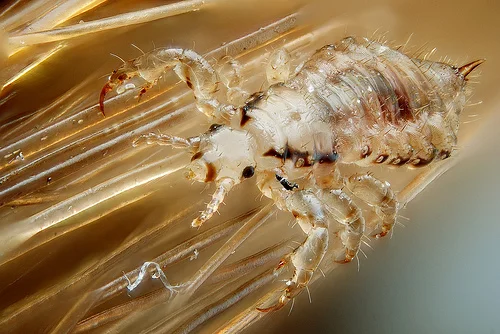It’s enough to make your skin crawl: If head lice weren’t scary enough, 60 percent of the itchy pests are now resistant to one or more common treatments, according to a new study published in New England Journal of Medicine.
More alarming still, the researchers report that in some states-—including Texas, California, and Florida—100 percent of the lice tested carried resistance genes to pyrethroids, the most widely recommended pesticides. These chemicals are found in such over-the-counter products as Nix, RID, and generic equivalents, as well as in prescription formulations.
Some researchers also warn that the blood-sucking parasites are starting to become resistant to even the strongest insecticides, such as malathion. Head lice are now the leading childhood contagion, attacking up to 12 million American kids each year, according to the Centers for Disease Control and Prevention (CDC).
Preschool or elementary school students are most likely to suffer infestations. Outbreaks are now so common that some schools asked parents to debug their kids during spring break so they would return to class lice-free, WoodTV.com reports.
It’s easy to see why schools are worried. Last year, an Idaho elementary school shut down for a week after 60 students and nine staffers contracted the itchy critters.
Researchers around the world have warned for years that head lice are developing immunity to the insecticides in OTC and prescription shampoos. Nor can they be “suffocated” by such home remedies as slathering the head with mayonnaise, olive oil, vinegar, or petroleum jelly, a study published in the Journal of Pediatric Nursing reports.
These increasingly hardy critters, known as “super lice,” are physically tougher than their six-legged counterparts of the past. Some experts report that today’s lice have thicker exoskeletons and have changed their hatching and egg-laying cycles to foil conventional treatment schedules.
“If an organism is exposed to something that could kill it, it develops defenses,” says Deb Lonzer, MD, chair of the department of community pediatrics at Cleveland Clinic Children’s Hospital. “Lice that survive chemical treatments pass on their genes and that leads to resistant lice.”
The wingless insects are about the size of sesame seeds and feed by sucking blood from the scalp. They’re most likely to be resistant to pyrethrin (the chemical found in Nix) or permethrin (the chemical in RID), says Lee Moorer, MD, a Denver, Colorado emergency medicine specialist and father of two. These drugs are neurotoxins for lice that have been the mainstay of treatment.
“These drugs are no longer working, so parents are forced to turn to more toxic prescription drugs to treat kids or try natural methods like coating the head with Vaseline that may not be effective,” adds Dr. Moorer.
Dr. Lonzer has seen many cases of resistant lice. “Parents will tell me, ‘I tried this, and I tried that, and nothing worked.” Typically the creepy crawlers tend to become resistant to the insecticides most widely used in that community. “Lice in Cleveland can be resistant to chemicals that are effective in Cincinnati.”
However, parents shouldn’t panic, adds Dr. Lonzer. “People completely freak out about lice due to gross-out factor and attack very hard with chemicals, but unlike ticks or mosquitoes, lice don’t transmit any diseases—they just make the scalp itchy.”
One Mom’s War Against Super Lice
Getting rid of super lice can be an epic battle. In a recent Slate article, KJ Dell’Antonia chronicles a yearlong ordeal, as she tried treatment after treatment to rid her four kids—and herself—of highly resistant infestations:
“October was Nix. November: Licefreeee. (Or so we thought.) December: RID and the electric “Robi” comb, which claims to “detect and destroy” lice on contact,” she wrote.
“January brought still more lice, skipping among our four children’s heads and mine like six-legged swingers, and a return to RID. In February, we tried a representative of the Lice Doctors. After March’s pulling-out-all-the-stops prescription-only malathion treatment, we were sure we had finally won, and so let our guard down in April, only to find in May that the lice had returned in full force.”
In the end, the infestation was defeated with a combination of combing and a highly toxic prescription treatment called Lindane. The FDA warns that Lindane (found in such products as Kwell) can have potential health risks—including three reported deaths and neurological side effects. It should only be used after other therapies have failed and with caution by anyone weighing less than 100 pounds.
Decades earlier, when Dell’Antonia’s mom, a teacher, contracted the pests, a single treatment with Nix solved the problem.
Fortunately, it’s still possible to get rid of super lice, because none are resistant to all treatments, Drs. Moorer and Lonzer emphasize. Along with treating the scalp, machine wash and dry bedding and clothing the infected person has used, soak combs and brushes in hot water for 5 to 10 minutes and vacuum the floor and furniture in areas where the infected person has recently sat or slept.
Head lice can’t survive more than 48 hours after falling off their host, so it’s not necessary to spend a huge amount of time cleaning and vacuuming, the CDC reports.
The American Academy of Pediatrics’ first choice treatment is products that contain permethrin, such as Nix, with the application to be repeated after seven to 10 days. The AAP reports that it typically kills about 70 percent of nits (lice eggs) and leaves a residue on the hair that will help kill lice that hatch. It’s also helpful to comb out nits.
However, because this treatment, while very safe, is becoming less effective, says Dr. Lonzer. Other options include:
-
- Shaving the child’s head. “This is both safe and 100 percent effective, so that’s what I’d do if my sons got lice,” says Dr. Moorer. “However, I can understand that parents of girls wouldn’t find this an appealing solution.”
- Treatment with the Lousebuster device. These treatments, offered at hair salons that treat lice and nits, have been effective for several of Dr. Lonzer’s patients. However, she cautions that trying a hair dryer at home will not work and risks blowing lice around the room. The device works by applying controlled heat to dry hair. According to a study published in Pediatrics, one 30-minute treatment killed nearly 100 percent of lice eggs and 80 percent of hatched lice.
- A 2012 study published in the New England Journal of Medicine reported that the antiparasitic drug ivermectin (Sklice) was 95 percent effective at treating resistant head lice. In February, Sklice lotion was FDA-approved as a lice treatment for kids ages 6 months and older. In two clinical trials involving 781 patients, fewer than one percent experienced such side effects as eye irritation, dry skin, or dandruff.
Source






